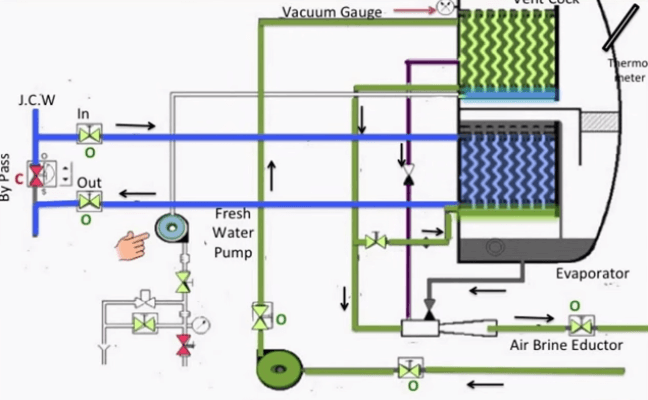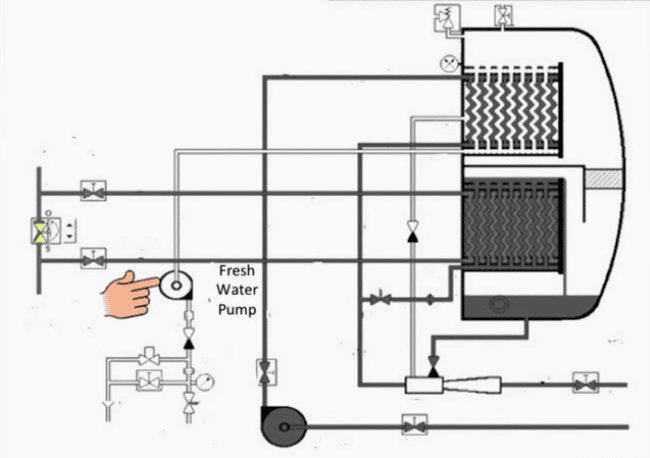How Do Navy Ships Make Fresh Water
Fresh water generator, i of the important machinery on board a ship, is something that cannot be done without. Fresh water produced from fresh h2o generator is used for drinking, cooking, washing and even running other important mechanism which utilise fresh water as a cooling medium.
Fresh water is generally produced on lath using the evaporation method. There are two things that are available in enough on transport to produce fresh water –Seawater and oestrus. Thus fresh water is produced by evaporating bounding main water using heat from any of the rut source. The evaporated sea water is then again cooled by the body of water water and the cycle repeats.
Mostly the heat source available is taken from the primary engine jacket h2o, which is used for cooling the main engine components such as cylinder head, liner etc. The temperature available from this jacket water is about seventy deg. centigrade. Simply at this temperature the evaporation of h2o is non possible as nosotros all know that the evaporation of water takes place at 100 deg centigrade nether atmospheric pressure level.

Thus in order to produce fresh water at seventy degrees we need to reduce the atmospheric pressure, which is done by creating a vacuum inside the bedchamber where the evaporation is taking place. Besides, equally a result of the vacuum the cooling of the evaporated sea water will besides take place at lower temperature. This cooled water is collected and transferred to the tank.
Nowadays, reverse osmosis is one of the methods which are used on board for generating fresh water. By and large this is used on passenger vessels wherein there is a large requirement of fresh h2o production. However, in merchant ships the evaporation method is used every bit reverse osmosis is costly and includes big maintenance toll for membrane.
Fresh Water Generator System
The main body of a fresh water generator on the send consists of a large cylindrical body with 2 compartments. One of the compartments is the condenser and the other is the evaporator. The fresh water generator as well consists of an educator which helps in generating the required vacuum. The fresh water pump and ejector pump helps in transfer of h2o to and from the fresh h2o generator.
Starting the Fresh Water Generator
- Before starting the fresh h2o generator we have to check that the ship is not in congested water, canals and is xx nautical miles away from the shore. This is done considering well-nigh the shore the effluents from factories and sewage are discharged into the sea tin go into the fresh h2o generator.
- Bank check whether engine is running higher up l rpm, the reason for this is that at depression rpm the temperature of jacket water which is around 60 degrees and non sufficient for evaporation of h2o.
- Check the drain valve nowadays at the bottom of the generator is in shut position.
- Now open suction and belch valves of the body of water water pump which will provide h2o for evaporation, cooling and to the eductor for creating vacuum.
- Open the body of water h2o discharge valve from where the water is sent back to the ocean after circulating within the fresh h2o generator.
- Shut the vacuum valve situated on top of the generator.
- Now showtime the sea water pump and check the pressure of the pump. The pressure is generally 3-4 bars.
- Wait for the vacuum to build upwards. Vacuum should be at least ninety% which tin can be seen on the gauge present on the generator. Generally the time taken for the generation of vacuum is about 10 minutes.
- When vacuum is achieved open up the valve for feed h2o treatment, this is to prevent calibration formation within the plates.
- Now open up hot h2o (jacket water) inlet and outlet valves slowly to virtually half. Always open the outlet valve get-go and so inlet valve. Slowly first to increase the opening of the valves to full open.
- Now nosotros can meet that the boiling temperature starts increasing and the vacuum starts dropping.
- The vacuum drop to most 85% which is an indication that evaporation is started.
- Open up the valve from fresh water pump to drain.
- Switch on the salinometer if information technology has to be started manually. Generally it is on auto start.
- At present start fresh h2o pump and gustation the water coming out of the drain.
- When fresh h2o starts producing it is seen that the boiling temperature drops over again slightly and vacuum comes back to the normal value.
- Check the h2o coming out of the salinometer is not salty and too check the reading of the salinometer. This is done to see if the salinometer is working properly or not and to foreclose the whole fresh water from getting contaminated with salt h2o. The value of salinometer is kept below 10ppm.
- After checking the gustatory modality of the water coming out of the salinometer, open valve for tank from the pump and close bleed valve.
Stopping the Fresh h2o Generator

- Close the jacket h2o inlet valves. Mostly inlet is closed starting time and then the outlet valve.
- Close the valve for feed water treatment.
- Terminate fresh water pump.
- Switch off the salinometer.
- Stop sea water pump (also known as ejector pump).
- Open vacuum valve.
- Close ocean water suction valve and overboard valve. This is generally not required as they are non- return valves. Notwithstanding, in case of valve leaking or impairment, these valves are to exist closed without fail.
Spotter this video for better agreement of how freshwater is generated:
You may besides similar to read – Concept: A Life Raft that Makes Drinking Water from Seawater
How Do Navy Ships Make Fresh Water,
Source: https://www.marineinsight.com/guidelines/converting-seawater-to-freshwater-on-a-ship-fresh-water-generator-explained/
Posted by: davisonated.blogspot.com


0 Response to "How Do Navy Ships Make Fresh Water"
Post a Comment